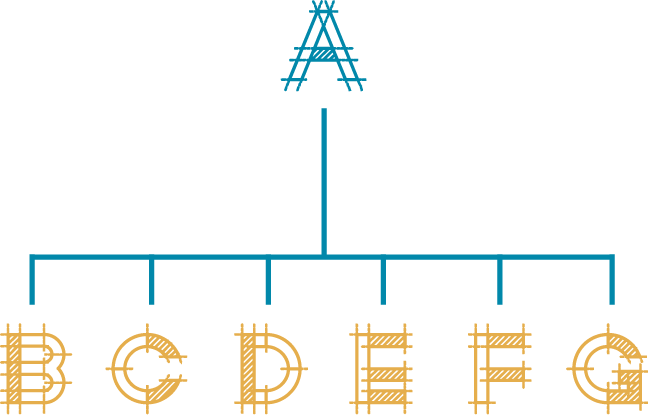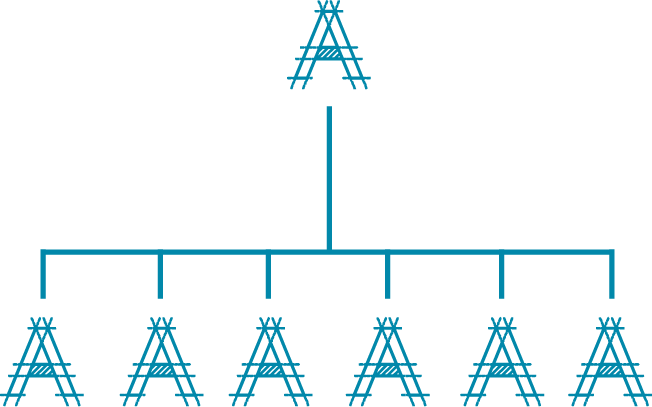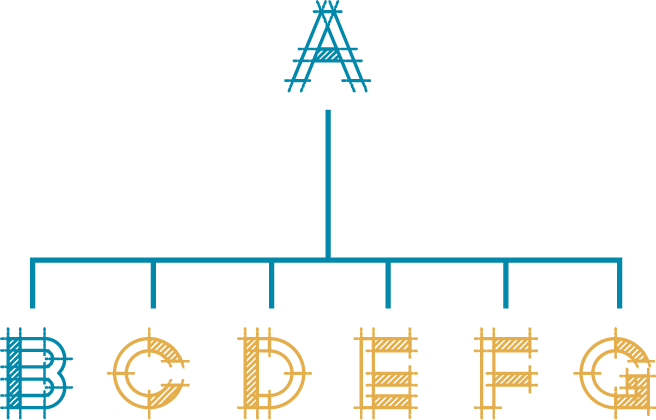Architecture of a School District Brand
What the structure of your school brands has to do with your district’s goals

At SchoolCEO, when we talk about branding, we’re often referring to your district’s high-level reputation. But sometimes it’s necessary to get into the weeds, to take a close look at the details of your brand—the logos, names, images, colors, and anything else that represents your organization—and assess their consistency.
When entering a new district, leaders often find themselves inheriting a school brand—and sometimes, that brand is in a state of disarray. If that’s the case for you, you aren’t alone. And chances are you’re already thinking about how to move your district toward school brand alignment.
In the marketing world, conversations about brand consistency and alignment center around the concept of brand architecture. Put simply, brand architecture is the structure of an organization’s brand(s). Understanding brand architecture better will give you the language and frameworks necessary to streamline your strategy and bring your district’s brand into order.
Do your school brands follow a house of brands structure?
First, let’s talk about the house of brands structure, in which several sub-brands exist under the umbrella of a parent brand.

When was the last time you bought something from Procter & Gamble Co.? Not sure? What about the last time you bought Gain detergent? Used a Swiffer mop? Brushed your teeth with Crest toothpaste? P&G is the parent brand to dozens of sub-brands ranging from fabric care to razors. Their brand architecture falls squarely in the house of brands category. One house—P&G—contains multiple different sub-brands, all of which have their own logos and are visually distinct from one another.
In the context of education, a house of brands structure means that in addition to the district’s overarching brand, every campus has its own school branding and logo. The school brands are the sub-brands, and the district's brand is the parent brand.
The house of brands structure is common in districts with individual campuses that offer unique opportunities—like STEM-focused high schools or performing arts academies. Providing space for sub-brands to develop and flourish empowers individual school sites to market these kinds of programs better. That’s because distinct visual assets like logos, color palettes, and typography allow schools to differentiate themselves from other campuses in the district. And differentiation is a key component of marketing.
The house of brands architecture is also common for districts with multiple buildings at each level or districts that span a large geographic area. In both circumstances, it’s likely that community members identify more with their specific schools than with the district as a whole, so it makes sense for each individual campus to have its own brand identity. Such is the case for Putnam City Schools in Oklahoma.
“There isn’t a ‘City of Putnam City,’ so to speak,” says Jeff Bardach, former communications director for Putnam City Schools. “We’re a really large district in terms of square miles, and our actual school sites are within three different cities—Warr Acres, Bethany, and Oklahoma City. And all those cities actually have their own school systems.”
Because the district’s schools are so spread out—and so mixed in with other local districts—it can be difficult to maintain one unified identity. “It’s the individual schools that the students and families are most familiar with,” Bardach says. “That’s where they are every day.” And that’s why each individual school in the district has its own brand.
James L. Dennis Elementary School uses the color blue, and their mascot is the Dolphins. Kenneth Cooper Middle School uses the color gold, and they’re the Cougars. Putnam City North High School uses burgundy, and they’re the Panthers. Each school has its own identity. “Then, what we’ve tried to do is come behind that and build the culture of the district,” Bardach explains.
“When I first got to this district, I did a site visit at all 27 schools, and some of them didn’t have any district-branded imagery outside their buildings,” Bardach tells us. “Someone could drive down the road and, if they didn’t know any better, assume they’re looking at an Oklahoma City public school.” So they started flying district-branded flags outside of every Putnam City school and hung large posters of the district logo in each building’s office lobby. “We don’t want to take away from the individual identities of the schools,” says Bardach. “We’re just trying to add that district brand, too. It’s still Rollingwood Elementary, but it’s also part of Putnam City Schools.”
According to Bardach, the district’s next step is to standardize logos, mascots, and colors for each sub-brand. That can be the difficult part of maintaining a house of brands structure—there are multiple brand guidelines to build and guard. However, if you’re looking to grow pride at each of your schools, develop each campus’s identity, and lean into community relationships at the building level, the house of brands structure just might be the framework you need.
Do your school brands fit into a branded house?
Whether or not your district uses Google Workspace, you’ve probably heard of Google Drive, Google Docs, Google Maps, Google Calendar, and Gmail. Google is a branded house. Every sub-brand is a reiteration of the parent brand.

In the education sector, if you take the branded house approach, then your district brand is the only brand. There are no separate brand guidelines for each building. The elementary school’s letterhead uses the exact same logo as the high school’s. The point is to establish consistency across all school sites. This is the strategy used by Jefferson West USD 340 in Kansas.
“Everyone around us was growing,” says Jason Crawford, superintendent of Jefferson West. “We had a lot of brand confusion, and we were seeing that radiate through the system in a bigger way. Kids didn’t have a central focus. There wasn’t a culture to get behind.” And that’s why Jefferson West undertook a major brand overhaul. Not only did they conduct a full-scale rebrand, but they took the time to listen to their stakeholders, to create a unified identity together, and then share the importance of that unified identity both internally and externally. “We have the capacity to grow,” Crawford says. “But we need to tell our story.”
According to Crawford, Jefferson West had historically been the premier school in the area. “West is best, that was the tagline,” he tells us. But over time, the district’s identity had weakened in the broader community. “I use the analogy of a Corvette sitting in the garage,” says Crawford. “It’s been sitting there for a long time. It looks beautiful, but, man, when you roll it out and open the hood, you discover all the damage the mice have done over time.”
With new open enrollment laws sweeping across Kansas, Crawford and his leadership team knew it was time to invest in the district’s identity. In order to remain competitive with surrounding systems—in terms of both student and teacher recruitment—they needed to make their mission known in the broader community. Having one unified, guarded brand allowed them to do just that.
But the benefits of a branded house approach don’t end with displaying the same logo on every school’s website. Developing one well-thought-out brand system led Jefferson West to launch other initiatives like “Family Fridays.” On these days, staff and students are encouraged to reflect on the core values at the heart of the district’s brand. The district releases a post online that unpacks one of their values, and anyone who wears their Tiger Paw T-shirt is entered into a drawing for a gift card donated by a member of the community. “We talk about those core values to build culture, to build our brand, and to build a community understanding of who we are,” Crawford says.
Of course, if you’re an incredibly large district, it might not make sense to try and keep every single campus aligned with your district brand. In fact, trying to keep that many people on board the same ship may prove disastrous. But if, like Jefferson West, you’re trying to build a strong presence in your community—if you’re looking to unite behind one image, to speak with one voice—the branded house approach may be the way to go. Just make sure you have some really solid brand guidelines to fall back on. Jefferson West’s guidelines, for example, touch on everything from their “commandments of typography” to common errors with logo usage.
Do your school brands make a blended house?
Let’s consider for a moment that what’s best for your district might fall somewhere in between the branded house and house of brands approaches. Fortunately, in the world of marketing, there is something known as a hybrid brand architecture, or a blended house. This structure melds together what works best about the two approaches we’ve unpacked so far.

The Coca-Cola Company is a great example of the blended house approach. One of Coca-Cola’s sub-brands is also called Coca-Cola, but they have other sub-brands, too, like Fanta, Dasani, and Powerade. The purpose of the blended house strategy is to make space for both flexibility and unity.
Many mid-sized school districts might benefit from the blended house structure. These districts often have several elementary schools and middle schools, but only one high school. If the district is the Coca-Cola Company, then the high school is the Coca-Cola sub-brand, while one of their elementary schools is Fanta and another is Dasani.
Taking the blended house approach to school brand alignment often means finding creative ways to strike a balance between versatility and harmony. Take, for example, Hempstead ISD in Texas, where individual school sites have their own unique brands, but those school brands are also clearly related. They’re all aligned under the district’s umbrella.
“When I first came in, none of the different logos, seals, or mascots were consistent,” says Valonia Walker, Hempstead ISD’s chief communications officer. So Walker initiated a rebranding project to help strengthen the district’s brand. “At Hempstead ISD, we’re all Bobcats,” Walker says, “but I wanted to see a progression of the Bobcat across school sites. I wanted to show the transition between the different campuses.”
The logo for the district’s early childhood center, for example, is a baby Bobcat. “They don’t really know what it means to be a Bobcat just yet. It’s their first introduction,” Walker explains. At the elementary campus, it’s still a baby Bobcat, but now the mascot is wearing a T-shirt. “Those students are going to the football games,” she says. “They’re seeing older students coming over to read to them wearing their jerseys. So they’re getting excited about what it means to be a Bobcat.” At the middle and high school levels, athletics are introduced, so Walker wanted those Bobcats to look fierce—the fiercest being the high school’s mascot.
“We want our campuses to take ownership and have pride,” Walker says. “We want to nurture that at each grade level. You don’t just get pride when you get to high school. We want them to be proud of their whole community and proud of their specific schools.”
To ensure that each school feels empowered to manage their own brand—while also remaining compliant with the district’s overarching brand—Hempstead ISD has made their school branding guidelines readily available online. “People go rogue in a minute,” Walker says. “They’ll take that Bobcat, and it will become a cougar all of a sudden.” Hempstead ISD has counteracted that tendency by sharing color codes, branded fonts, and logo iterations online for each school site, as well as for the overarching district brand.
No matter what brand architecture your district uses, understanding the structure of your brand will help you maintain control—and that is everything. “Before we did this, there was too much room for people to tell our story for us. So this is our way of taking it back,” Walker says. “This is our way of coming back stronger, of saying that this is our brand, this is our voice, this is who we are, who we want to be, and where we’re going.”
Marie Kressin is a writer at SchoolCEO and can be reached at marie@schoolceo.com.
Subscribe below to stay connected with SchoolCEO!

